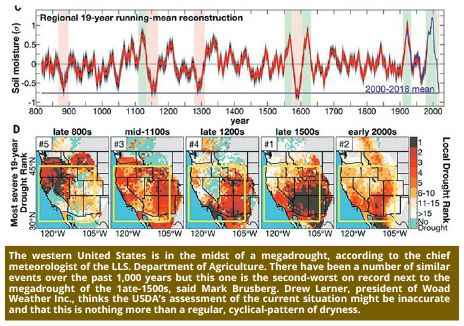Weather experts disagree on how 2021 fits into historical patterns
The drought that has gripped the western United States is far from typical, says the chief meteorologist of the U.S. Department of Agriculture.
“This really is a drought of historical significance,” Mark Brusberg told his USDA colleagues in a recent webinar.
In fact, it qualifies as a “megadrought,” since at least some portion of the western U.S. has been experiencing drought since 2000.
“It never really went away and that’s the characteristic of a megadrought,” said Brusberg.
Scientists have discovered a number of megadroughts in the U.S. over the past one thousand years by analyzing tree rings and pollen records.
This one appears to be a doozy. It ranks as the second worst on record, next to one in the late 1500s.
“You have to go back 500 years to see dryness to this extent and this severity,” he said.
Drew Lerner, president of World Weather Inc., thinks Brusberg is blowing things way out of proportion.
“We don’t have good records of what took place thousands of years ago. Come on,” he said.
Lerner also bristles at using the term megadrought to describe what’s going on in the western U.S.
“It’s so inflammatory and so out-of-line with what data we have. It’s irresponsible,” he said.
“They’re trying to scare the world to death and they’ve got very little data to base it on. It ticks me off.”
Brusberg firmly believes the western U.S. is in the midst of a megadrought caused by the “profound warming” trend over the past 30 years due to climate change.
Water levels in Lake Mead, the largest water reservoir in the U.S., have fallen 43.6 meters between June 1998 and June 2021. It is now at 36 percent of its capacity.
If the megadrought lasts another 10 or 20 years the lake will be in danger of falling below the level at which Hoover Dam can generate electricity.
In California’s Central Valley people have drilled so many wells that the land is starting to sink as aquifers compress.
“Think about flattening a sponge,” said Brusberg.
Lerner said the situation in the western U.S. is tightly associated with the 22-year solar cycle and is something that has happened many times before.
It is not out of the ordinary but is garnering an inordinate amount of media attention this time around because populous states like California have become massive consumers of water.
“The amount of water demand needed for agriculture has gone through the roof,” he said.
One thing both of the weather watchers agree on is that there is definitely a significant drought happening in 2021. The latest map shows much of the western U.S. and the Northern Plains regions are experiencing extreme to exceptional drought. The USDA is forecasting a national average spring wheat yield of 30.7 bushels per acre, the lowest since 2002.
The good news is that the ridging and dryness in the western half of the country has resulted in wet conditions in the eastern half.
“Whenever you have one dominant pattern over one part of the country you usually see a compensation in another part of the country,” said Brusberg.
That is why winter wheat yields are forecast at 53.6 bu. per acre, the second highest on record.
So while farmers in the Dakotas are looking at severely reduced yields, their counterparts in Illinois are poised to harvest what could be a record crop of corn and soybeans.
The bad news is that Brusberg thinks the current megadrought might not have an end like the previous ones, which were often followed by prolonged wet spells.
He thinks this one could be perpetual due to climate change, so farmers might have to get used to living with more of the same hot and dry conditions.
Lerner thinks that is a load of bunk, although he does believe the drought will persist into 2022 in both the U.S. and Canada.
He is forecasting another tough spring and early summer in the eastern portion of the Canadian Prairies next year.
But there should be some relief later in the growing season as the U.S. drought expands further into the western corn belt, pushing the ridge further east.
At that point there should be some better rains in Saskatchewan and southern Alberta.
Lerner is not forecasting a megadrought that lasts another 10 or 20 years for either Canada or the U.S. and he firmly believes there will be return to wet conditions in the not-to-distant future.
By Sean Pratt | The Western Producer | producer.com/news/megadrought-or-mega-hype/

